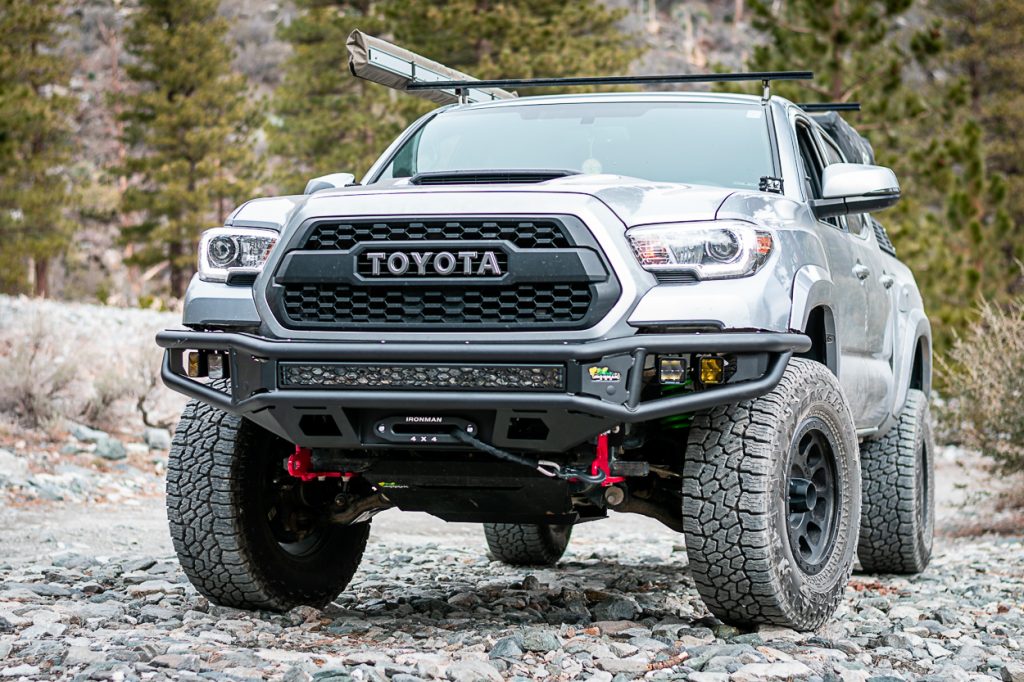
So, you’ve finally decided to bite the bullet and upgrade your Tacoma’s tires from stock highway terrains to a more aggressive tread. You get to searching and quickly realize that finding the right tire size and tread pattern is going to be a more difficult task than you initially thought. With the seemingly endless vendors and countless brands, finding the right tire can be a bit intimidating.
Luckily, you’ve come to the right place to determine what kind of tire best fits your needs. In this article, we’ll be covering all of the differences between all-terrain and mud-terrain tires as well as discussing when you may want one type of tire over the other.
While this post will dive into AT and MT tires, it would be valuable to understand the tire buying and selection process in even more detail. If you’re looking for an general, but detailed post on selecting new tires, check out our tire guide here. We go through all the numbers, designations, and even some popular tires in various categories.
Table Of Contents
Overview
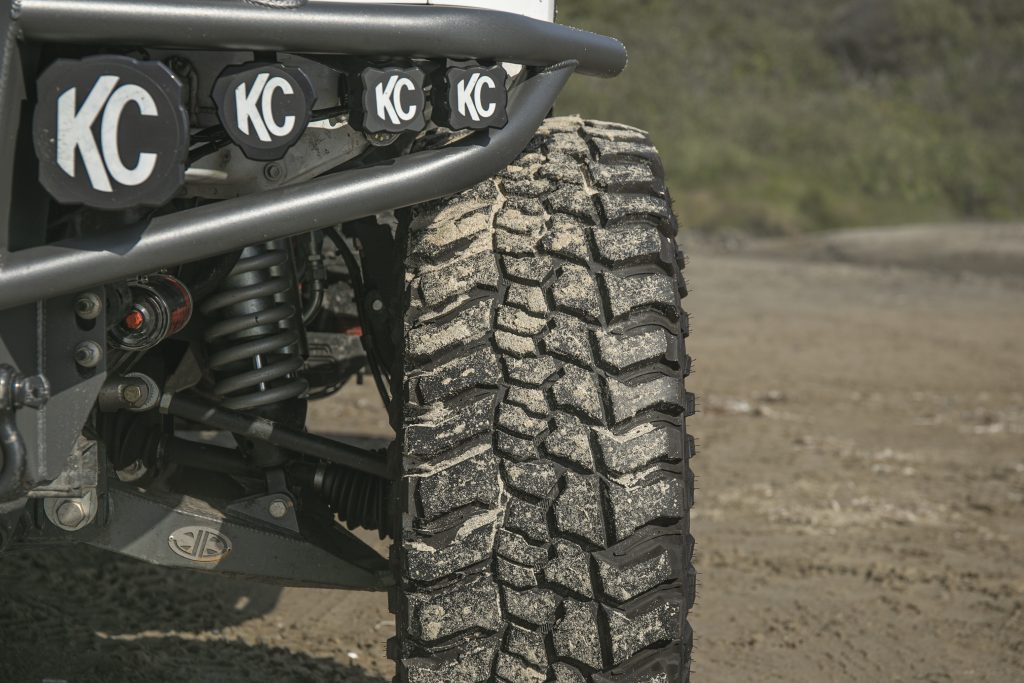
If you find yourself doing most of your driving on pavement and taking the occasional off-road camping trip, the all-terrain is probably the most practical option for you. Typically, Tacoma owners that just want a more aggressive and functional off-road tire will purchase a set of all terrains for many reasons.
One of the main reasons an all-terrain tire is a solid upgrade option from a set of street tires is because in most cases, the carcass on both tires is relatively similar. This means that when it comes to the sidewall and ply construction, both tires can share a lot of characteristics. Even though many all-terrains will feature a thicker sidewall and more plies than a regular highway tire, options are available to get basically a highway tire with an all-terrain tread.
Maybe you do a lot of off-roading and live in the PNW where the ground is constantly wet. A/T tires might not cut it. With deeper, wider tread blocks and gaps for mud ejection, you won’t have to think twice about this option if you know you’ll be faced with a lot of mud and wet terrain where that kind of grip is essential.
1. Tire Specs

Typically when you’re looking at getting more aggressive tires, you’re also looking at bumping up an inch or two. Many Tacomas come from the factory with LT265/70R17 tires.
After adding an even a mild leveling kit, those 265s begin to look a little too small. Naturally, you want your Tacoma to look nice and proportional, having a bigger tire has its advantages, with probably the biggest being a wider contact patch. First, you have to understand how to read tire sizes, especially if it’s metric.
2. Load Range

Let’s start off with the first thing you’ll see when looking at your tire dimensions: “LT”.
This tells you what kind of tire you have. In our case, the LT stands for “Light Truck”, and is rated for light-duty, heavy-duty pick-ups and SUVs. Sometimes, you may also see a “P” which stands for “passenger”. You’ll see this typically on sedans and crossovers.
This specification also ties into load range. Load range is specified by a single letter such as C, D, or E, and tells us how many plies are in a tire.
- C Load = 6-ply
- D Load = 8-ply
- E Load = 10-ply
You’ll typically only see C and E ply tires, but occasionally a D Load tire will make an appearance.
At this point, you’re probably asking yourself what kind of load tire you should get. Well, that really all depends on your driving habits. Do you find yourself doing a lot of rock crawling? Mostly on-road driving? Occasional weekend camping trips?
If your tires will be making a significant amount of contact with big rocks, you’ll want to go with an E-load tire. This helps you to air your tires down as low as 10 PSI to give you the widest contact path possible. Airing down also helps preventing leaks if you were to roll over something sharp due to the thickness of the tires.
When you air down your tires, the tread will conform to the shape of the terrain allowing your tires to get more “bite” where a fully inflated tire would be spinning. When rock crawling, you don’t want to have a sharp rock puncture your tire and ruin a day on the trails.
If you were to run a C load and E load tire on the same terrain, you’d run a significantly higher risk of a rock puncturing your C load tire than if you were running the E loads. There is debate about this in some circles, but in theory, and usually practice, the thicker sidewall should perform better here.
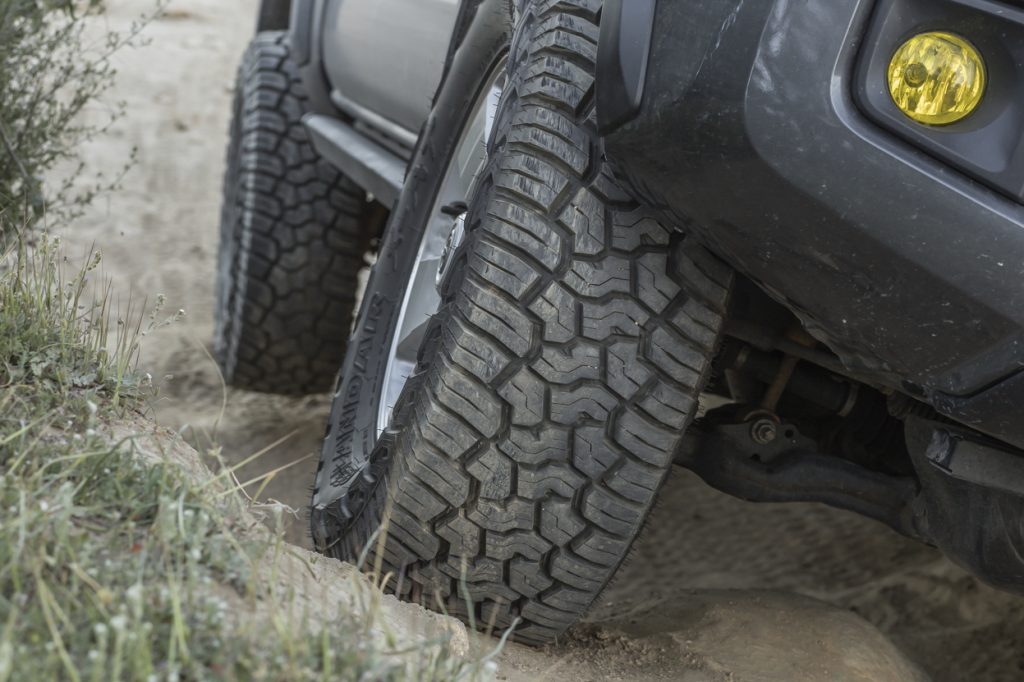
While having an E Load tire might sound like the best choice, there of course have to be some negatives where the most impacted part being gas mileage. Yes, your MPGs will take a hit when throwing on an E load tire since it is heavier than the stock load street tires that come with the Tacomas. But, you don’t want to be caught having to swap in your spare while sitting on top of a boulder. Besides, it’s smiles per gallon, right?
If your activities only involve light off-roading on forest service roads with the occasional obstacle, you can get by just fine with a C load tire and not have to sacrifice your economy. However, this will only apply if you want an A/T tire because most M/T tires don’t come in anything but E load. Even then, there are many all-terrain tires that come in E load only.
For reference on options, there are a ton of C load A/T tires. For C load A/T tires, many people consider the Falken’s Wildpeak AT3W and the incredibly popular BFGoodrich’s KO2.
If the A/T tires aren’t strong enough, D or E load tires are going to be your next step, although as we mentioned above, you might see a decrease in MPGs. This can range depending on which tires you’re comparing, the main difference that you’ll feel the most is the stiffness of the ride. Naturally, the thicker the sidewall, the less give it has, the more stiffness you’ll feel in the cabin. Is it a massive difference? It depends on who you ask. Eventually, most drivers get used to it.
Heavy-duty D and E tires are just that, heavy-duty but they do come with a price. The ride is going to be stiffer, the price is typically higher, and the weight is usually significantly more over C load which is ultimately harder on your Tacoma. With upgraded larger 33″ or 34″ tires in the D or E load range, your Tacoma has to work harder to rotate the new unsprung rotational mass which puts strain on all your suspension components and drivetrain ultimately leading to replacing your factory ring and pinion gearing ratio.
Larger/heavy tires will cause your transmission/shift points to change as you ascend grades. After running larger/heavier tires – everything else starts to change.
Pay attention to the weight differences in the tires you buy, whether it be load range C, D, or E. This is a very important factor to determine when you’re buying tires for your Tacoma.
3. Aspect Ratio
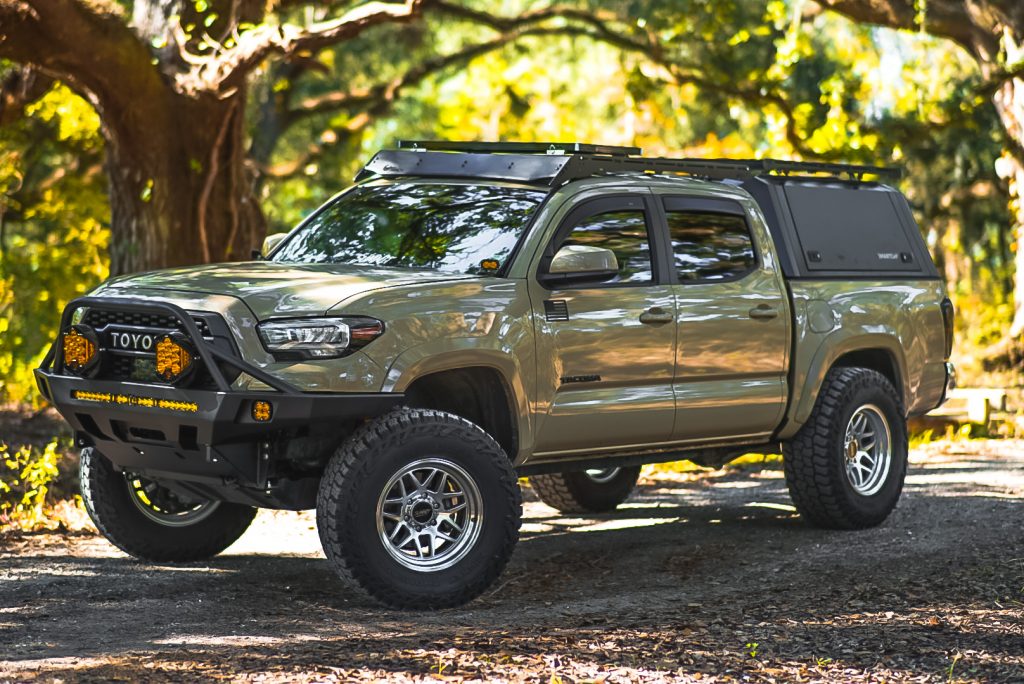
Looking at the numbers next to the LT, we see 265/70. This is called your “Aspect Ratio”.
- 265 represents how wide your tire is in millimeters
- 70 represents how tall your tire is, or how far the top of the tread is from the outer edge of the rim
- R17 refers to your rim’s diameter in inches
Most people who start off with their build only do a 2-3” leveling kit which can fit 33s, or in our case 285/70/R17. Since this is a wider tire by 20 millimeters, it also has to be about an inch taller than the 265s to accommodate for the extra tread width. Be prepared to trim a little bit when trying to fit these tires. Check out the guide to fitting 33s on a Tacoma post.
When looking at the contact patch, the same typically applies to both A/T and M/T tires, just as long as you’re comparing the same sizes. This doesn’t really apply to tire ratios of 265 or smaller, but for anything wider than a 265, the tire is making more contact with the ground. Therefore, you’ll be getting a better grip, shorter braking distance, and an overall improvement in handling when comparing, for example, a 265 KO2 to a 285 KO2.
4. Siping

When looking at all-terrain and mud-terrain tires, one of the main things you should be considering is improving off-road traction – but have you considered on-road?
What if the roads are wet? Well, similar to street tires, mud and all-terrain tires have little slits in their tread/surface lugs called “siping”. These little slits actually increase your tire’s traction in wet or icy conditions. Depending on the quality of tire you buy, some will come with more sipes than others, thus giving you better traction.
However, most of the tires on the market are generally very solid options, especially from big-name brands such as BFG, Cooper, Nitto and Yokohama. Since most Tacoma owners use their rigs as daily drivers and weekend adventure vehicles, on-road traction is equally as important as off-road.
Now, how do all-terrains compare to mud-terrains when it comes to siping? Generally, A/T tires will have more sipes to cover “all terrains”, whereas M/T tires have an emphasis on more off-road use. Therefore, less siping is found on M/Ts. Personally, I run the Yokohama Geolandar G003 M/T and haven’t had any issues with losing traction in wet conditions. If anything, I feel almost as if traction is improved because of the wider contact patch, which leads us into our next topic of discussion.
If you live in an area where it rains often, you may want to consider an A/T with lots of siping or if you must buy an M/T, make sure it’s a 3PMSF (3 Peak Mountain Snowflake) rated tire or at the minimum, has lots of siping. The Cooper EVO M/T is one very popular mud terrain that does well in wet on-road conditions.
5. Road Noise

Obviously, a more aggressive tire is going to produce more road noise compared to your average street tire. However, today’s engineers have been able to figure out how to keep road noise to a minimum without sacrificing the off-road functionality of the tires themselves. The root of road noise comes from wider gaps between tread blocks as well as the tread blocks themselves. Knowing this, it is evident that M/T tires will be a good bit louder than your typical A/T.
There are M/T tires on the market such as the Yokohama Geolandar G003 M/T and Nitto Trail Grappler that have minimal road noise for how aggressive they are. Granted, these tires are on the pricier side but you get what you pay for. Many of the A/T tires such as the Toyo Open Country AT3, KO2s, Falken Wildpeak AT3W have minimal road noise and retain all the same properties of an A/T, which is why they are perfect for your daily driver.
If you really don’t want to hear your tires when going down the road, you can add sound deadening material to your floorboard and doors, but that tends to be a pretty large task and most people end up dealing with the noise.
6. Treadwear

General Maintenance
The only maintenance tires really need are alignment, balance, and rotation. Getting an alignment is only needed when you know your truck’s geometry is out of spec; typically after replacing a suspension component such as coilovers, control arms or tie rods – or a hard day out on the trail. Balance and rotations should be done about every 5,000 miles, but some people will do this around every 3,000 miles (especially with M/Ts). It all really depends on the quality of the tire you purchased.
Since M/Ts are heavier than a street and A/T tire, they could get thrown out of balance easier especially if you’re an aggressive driver. Some will go longer than others when dealing with balancing and rotating their tires. The easiest way to tell if your tires are out of balance is by paying attention to the road noise. If you find that at certain speeds you hear what sounds like a wheel bearing failing and other speeds you don’t, it is time to get your tires balanced. Some tires are made out of a softer rubber compound than others. For instance, a KO2 is softer than a Falken Wildpeak, and a Cooper STT Pro M/T is softer than a Nitto Trail Grappler.
Typically, a softer rubber compound means a smoother ride with more maintenance, whereas a firmer compound tire has less maintenance. This might not always be the case with maintenance, but in many instances it is. It’s really all personal preference and what you want to sacrifice when it comes to maintaining your tires.
Tread Life
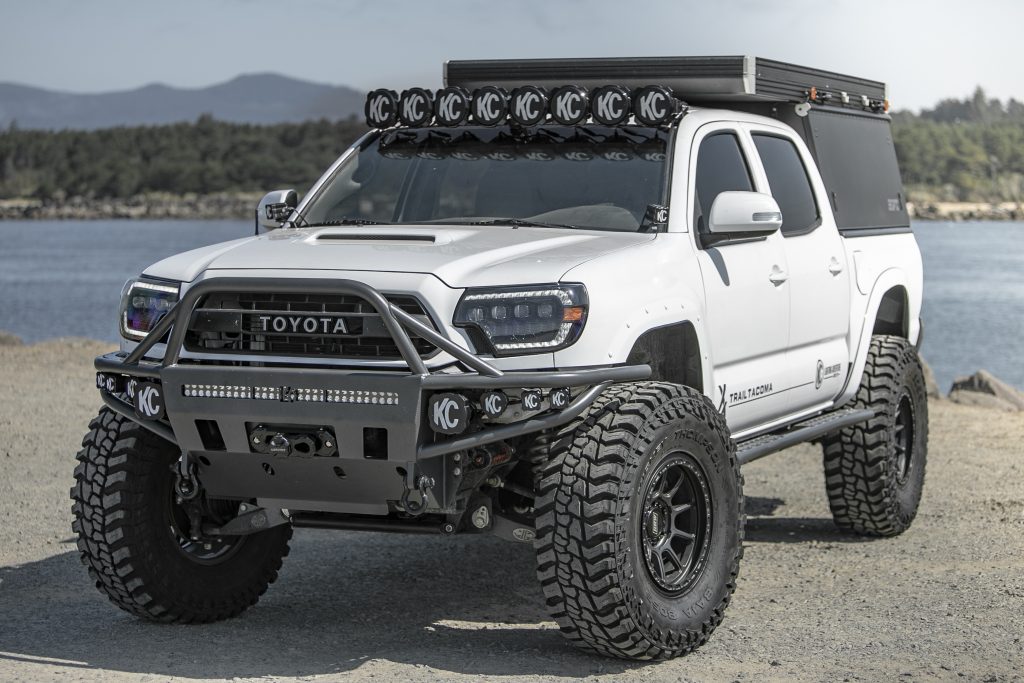
Pictured: Mickey Thompson Baja Boss M/T 37×12.5R17
Tread life or the general lifespan of your tires is determined by treadwear. If you have no tread, you end up with a poor performance from your tires. Many factors go into the life of your tread, starting with the driver. The harder push your tires, the faster the tread will wear. Other factors such as low/high air pressure, lack of rotation and alignment as mentioned above, and blown suspension parts all have the potential to contribute to treadwear.
There is one element that you can’t control from a maintenance perspective though; rubber compound. Hard rubber compounds typically found in A/T tires last longer than soft rubber compounds on M/T offerings. M/Ts feature large soft tread lugs which are prone to tire cupping, cracking, and tread separation overtime.
If you’re looking for a tire that will last the strength of time and provide you with a long tread life, you should choose a hard rubber compound such as a Toyo AT Xtreme, the Toyo AT3, or the Cooper AT3 XLT. If you’re looking to avoid short tread life issues, then do not buy soft rubber compound M/T tires such as the Maxxis Trepadors, or even the more commonly purchased tires; Toyo M/T and the Cooper STT Pro.
Final Thoughts

Hopefully, by now you have a little more clarity on which tires you might want to get for your Tacoma.
Finding yourself off-road in slick, muddy conditions most of the time? M/T.
Do you take an off-road camping trip every now and then, but use your Tacoma as your daily driver? A/T.
Mud Terrains
Pros
- Great for mud, sand, and rocks
- Aggressive looking
Cons
- Increased road noise
- Poor performance on-road wet
- Poor performance in snow
- Poor gas mileage
All Terrains
Pros
- Less road noise
- Great performance in wet conditions
- Great performance in snow
- Better MPGs over M/Ts
Cons
- Poor performance in mud, sand
At the end of the day, it’s really all up to you. People put M/Ts on their trucks and they never see mud or even a dirt road. Others will suck it up and take their A/Ts through the deepest mud and hope they can find a way out if they get stuck.
Regardless of which route you decide to go, you can’t go wrong with either when it comes to upgrading your tires to tackle the gnarliest trails you can find.

